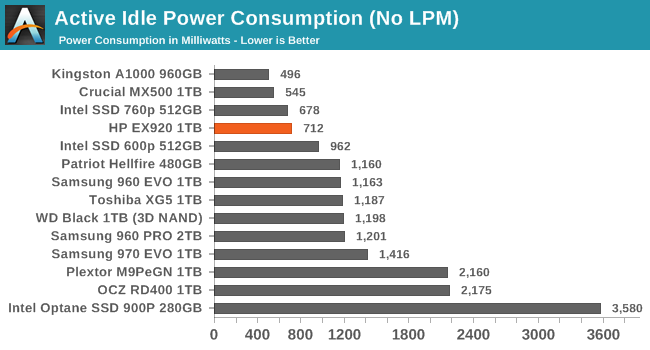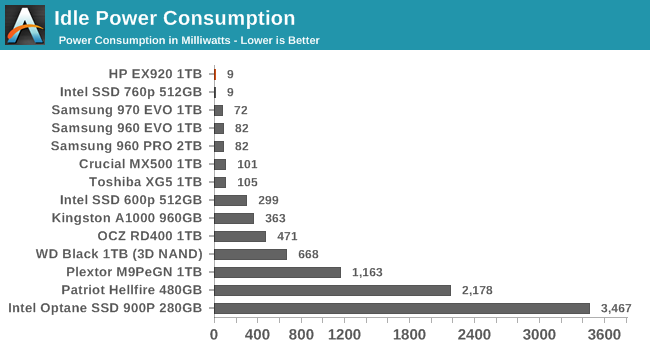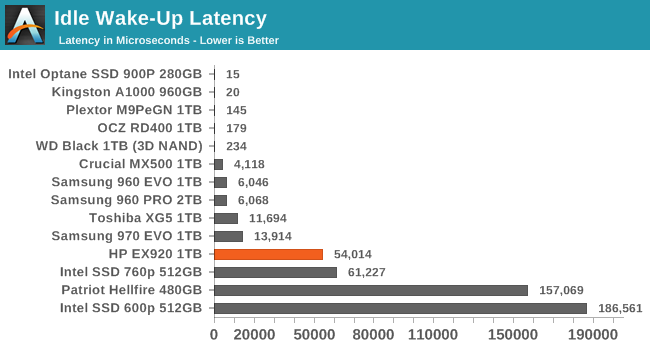The HP EX920 M.2 SSD Review: Finding the Mainstream Sweet Spot
by Billy Tallis on July 9, 2018 9:00 AM ESTPower Management Features
Real-world client storage workloads leave SSDs idle most of the time, so the active power measurements presented earlier in this review only account for a small part of what determines a drive's suitability for battery-powered use. Especially under light use, the power efficiency of a SSD is determined mostly be how well it can save power when idle.
For many NVMe SSDs, the closely related matter of thermal management can also be important. M.2 SSDs can concentrate a lot of power in a very small space. They may also be used in locations with high ambient temperatures and poor cooling, such as tucked under a GPU on a desktop motherboard, or in a poorly-ventilated notebook.
| HP EX920 NVMe Power and Thermal Management Features |
|||
| Controller | Silicon Motion SM2262 | ||
| Firmware | SVN105 | ||
| NVMe Version |
Feature | Status | |
| 1.0 | Number of operational (active) power states | 3 | |
| 1.1 | Number of non-operational (idle) power states | 2 | |
| Autonomous Power State Transition (APST) | Supported | ||
| 1.2 | Warning Temperature | 70°C | |
| Critical Temperature | 80°C | ||
| 1.3 | Host Controlled Thermal Management | Supported | |
| Non-Operational Power State Permissive Mode | Not Supported | ||
The HP EX920 implements most of the available NVMe features pertaining power and thermal management. The only omission is the optional Non-Operational Power State Permissive Mode, which lets the OS control whether the SSD can perform power-hungry background garbage collection even when it is supposed to be in a low-power idle state. This feature is only really useful for systems that are trying to maximize battery life even at the expense of degrading disk performance, and it's not a high priority for a performance-oriented drive like the EX920. The warning and critical temperature thresholds used by the EX920 are slightly lower than most competitors, but thermal throttling shouldn't be a big problem. The idle power states implemented by the EX920 advertise very low power draw and quick transitions in and out of idle.
| HP EX920 NVMe Power States |
|||||
| Controller | Silicon Motion SM2262 | ||||
| Firmware | SVN105 | ||||
| Power State |
Maximum Power |
Active/Idle | Entry Latency |
Exit Latency |
|
| PS 0 | 9 W | Active | - | - | |
| PS 1 | 4.6 W | Active | - | - | |
| PS 2 | 3.8 W | Active | - | - | |
| PS 3 | 45 mW | Idle | 2 ms | 2 ms | |
| PS 4 | 4 mW | Idle | 6 ms | 6 ms | |
Note that the above tables reflect only the information provided by the drive to the OS. The power and latency numbers are often very conservative estimates, but they are what the OS uses to determine which idle states to use and how long to wait before dropping to a deeper idle state.
Idle Power Measurement
SATA SSDs are tested with SATA link power management disabled to measure their active idle power draw, and with it enabled for the deeper idle power consumption score and the idle wake-up latency test. Our testbed, like any ordinary desktop system, cannot trigger the deepest DevSleep idle state.
Idle power management for NVMe SSDs is far more complicated than for SATA SSDs. NVMe SSDs can support several different idle power states, and through the Autonomous Power State Transition (APST) feature the operating system can set a drive's policy for when to drop down to a lower power state. There is typically a tradeoff in that lower-power states take longer to enter and wake up from, so the choice about what power states to use may differ for desktop and notebooks.
We report two idle power measurements. Active idle is representative of a typical desktop, where none of the advanced PCIe link or NVMe power saving features are enabled and the drive is immediately ready to process new commands. The idle power consumption metric is measured with PCIe Active State Power Management L1.2 state enabled and NVMe APST enabled if supported.


The active idle power consumption of the HP EX920 is pretty good compared to the competition. The 512GB Intel 760p draws a little less by virtue of having less DRAM to keep powered, and the Kingston A1000 with its PCIe x2 controller has the significant natural advantage of driving far few I/O signals. Otherwise, the EX920 represents about a 40% reduction from the typical active idle power for a 1TB high-end NVMe SSD.
When all the NVMe power features are turned on, the EX920 and the Intel 760p are in a class of their own, with power consumption dropping under 10mW even on our desktop testbed that often prevents NVMe SSDs from reaching their lowest idle states. The only way to get significantly lower idle power from an SSD is to use a well-engineered laptop that ensures full platform-level support for SATA DEVSLP (not available on any desktop) or PCIe ASPM.

The HP EX920's advertised power state transition latencies are proven to be extremely optimistic as the drive takes 54ms instead of just 6ms to wake up from its deepest idle state. But given just how low power consumption is in that idle state, 54ms of wake-up latency is a fair tradeoff and still fast enough to allow the OS to set a fairly aggressive power management policy.










32 Comments
View All Comments
DigitalFreak - Monday, July 9, 2018 - link
Too bad NVMe drives still have a price premium over SATA, but at least we're starting to get good performing drives without the ridiculous Samsung markup.bubblyboo - Tuesday, July 10, 2018 - link
I mean I just got a 512GB 970 Pro for <$200 but sure Samsung has a "ridiculous markup".grahad - Tuesday, July 10, 2018 - link
Sales don't really count. It's 229.99 on Amazon and Newegg at the moment.bubblyboo - Tuesday, July 10, 2018 - link
That's still not much since it's just about the only consumer 3D MLC NVME drive.Hectandan - Thursday, July 12, 2018 - link
There are still few SSDs besides Samsung with consistent performance under heavy workload, and I don't know why one needs NVMe at all if not for some kind of workload.shabby - Monday, July 9, 2018 - link
Can you guys start separating tests based on ssd sizes? Seeing a 1tb ssd benched against one half its size or even a quarter somewhat isn't fair.Billy Tallis - Monday, July 9, 2018 - link
The drives in this review that aren't 1TB are either representing controller+NAND combinations that I don't have a 1TB drive for, or are there to show how the same controller+NAND combination as the drive being reviewed scales with capacity.milkod2001 - Monday, July 9, 2018 - link
Would be nice if prices came down so this would be more popular and they would sell more. I mean 1TB m2 SSD under $100 would be nice. I doesn't cost them more than 20 bucks to make one anyway.mkaibear - Monday, July 9, 2018 - link
What's your source on that bill of materials? It sounds distinctly fishy to meRickyBaby - Monday, July 9, 2018 - link
Bought this drive off an Ebay store for $230 - on sale + 15% coupon and got it Friday. Installed in an Asrock Z97 mobo with an adapter card - thanks to Asrock for adding the pcie boot option to the bios awhile back. Did a fresh install of Win10 ... didn't want to disk clone and bring forward all the crap. Haven't done much with it yet ... it does boot very fast ! Ran a few benchies. Crystal Diskmark shows a 2,900 read and 1,700 write score for the Q32TI Seq speed ... not bad for an aging system !